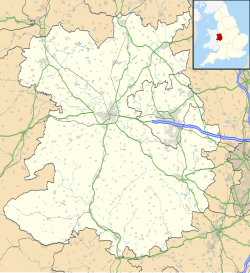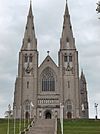Shrewsbury Cathedral
| Shrewsbury Cathedral | |
|---|---|
| Cathedral Church of Our Lady Help of Christians and Saint Peter of Alcantara | |
 | |
| Location | Shrewsbury, Shropshire |
| Country | England |
| Denomination | Roman Catholic |
| Website | shrewsburycathedral.org |
| History | |
| Consecrated | 1856 |
| Architecture | |
| Architect(s) | E. W. Pugin |
| Administration | |
| Province | Birmingham |
| Diocese | Shrewsbury (since 1856) |
| Clergy | |
| Bishop(s) | Mark Davies |
| Dean | Very Reverend Canon Stephen Coonan |
| Laity | |
| Director of music | Judith Hall |
| Organist(s) | Toby Belfield |
The Cathedral Church of Our Lady Help of Christians and Saint Peter of Alcantara, commonly known as Shrewsbury Cathedral, is a Roman Catholic cathedral in Shrewsbury, England. It is the seat of the Bishop of Shrewsbury and mother church of the Diocese of Shrewsbury which covers the counties of Shropshire and Cheshire, part of Greater Manchester and part of Merseyside.
History

Edward Pugin (the son of Augustus Welby Northmore Pugin) designed the cathedral, which was completed in 1856. He had planned a grand building with a tall spire but these designs could not be carried out due to the site's weak foundations. The spire had to be abandoned and the building scaled down, resulting in the building as it is today. Bertram, the Earl of Shrewsbury, financed the building but died three months prior to completion.
In 1984, the cathedral was re-ordered which brought it in line with the revised liturgy. Local Grinshill stone was used for the new altar which Bishop Gray consecrated in 1985.
Windows
Among the glories of Shrewsbury Cathedral has to be counted the stained glass. The older glass is mostly from the Hardman Studio in Birmingham, and the Cathedral is very fortunate to have seven windows by the Arts and Craft Artist Margaret Agnes Rope, who was the daughter of a local doctor. She later became a Carmelite nun, following training in Dublin. These seven beautiful windows were produced between the two world wars.
See also
- Gerard Moultrie classicist, third master and Anglican chaplain at Shrewsbury School translator of English lyrics of the Eucharistic hymn "Let All Mortal Flesh Keep Silence"
- Mother Cornelia Connelly (1809-1879) American convert and friend of the Earl of Shrewsbury, foundress of Society of the Holy Child Jesus a teaching order of consecrated women established for the catechesis and elementary education of Roman Catholic girls in England, expanding to the USA and beyond
External links
- Shrewsbury Cathedral Official Website
- Diocese of Shrewsbury Official Website
- The Catholic Church in England and Wales
- Vatican Official Website


